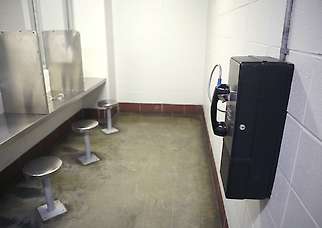 An interesting look at prison life in Massachusetts. The article states that there are only three inmate phones for over 800 prisoners. By providing a secure cell phone solution such as meshDETECT, the prison can significantly increase detainee access to their families while limiting the safety risks of the prisoner movement necessary to get the prisoners to the pay phones.
An interesting look at prison life in Massachusetts. The article states that there are only three inmate phones for over 800 prisoners. By providing a secure cell phone solution such as meshDETECT, the prison can significantly increase detainee access to their families while limiting the safety risks of the prisoner movement necessary to get the prisoners to the pay phones.
It’s where no one wants to go.
The shower floors are scarred from the blades of sharpened shanks. There are no televisions, radios, or hotpots allowed, and no access to the canteen. Pay phones on wheels are rolled to cells for brief calls, and some prisoners play chess by calling out their moves on separate boards in separate cells, where prisoners are required to spend 23 hours a day.
Pedro Tapia, 30, of Hyde Park, who was serving up to 15 years for armed robbery, was in the segregation unit – or hole – at MCI-Shirley medium-security prison for his third time after being accused of verbally assaulting a staff member.
“Everything is hard about being in here; you have to be mentally strong,” he said while in a cage-like outdoor space for his hour of fresh air. “I read so much that my eyes start to twitch to the point that tears come out.”
Unlike at minimum-security prisons, where inmates have much more freedom and are on a glide path to release, the vast majority of the state’s 11,500 prisoners live in a world bounded by monotony, violence, and strict routines, where barred doors and barbed wire etch the horizon and the purpose is punishment.
My visit to the hole was one stop on a three-day tour of the state’s prison system, including a period during which, with my permission, the state Department of Correction stripped me of my regular clothes and locked me in chains, to let me experience incarceration in a more personal, first-hand personal way. (Everyone interviewed knew I was a journalist.)
Over three days, I saw from an inmate’s perspective the stark difference between the bleak, highly controlled world of medium and maximum security — from which no one has escaped since 1990 — compared to the relative freedom of minimum-security prisons.
Our journey began at MCI-Cedar Junction in Walpole, a former maximum-security prison surrounded by 20-foot-high walls, eight observation towers, and five strands of electrical wire that has become the gateway to prison life in Massachusetts. Most inmates stay in this sprawling 56-year-old facility, which smells like formaldehyde on hot days, for two to four months while awaiting a permanent assignment.
New inmates are strip searched – with every orifice checked – scanned for metal objects and other contraband, fingerprinted, and given starchy gray scrubs, ill-fitting canvas shoes without laces, and a paper bag with essentials, including a dull razor, seven pairs of underwear, and a special pen designed so it can’t be used as a weapon. Any possessions, including their street clothes, are either destroyed or mailed home.
Correction officers and other staff check newbies for gang symbols, conduct medical and psychological evaluations, and advise them that bad behavior could affect whether they are classified to a maximum-security prison or a lower-security facility.
Cedar Junction is far less tense since it became a reception center in 2009 and assaults against other prisoners and staff have dropped more than 50 percent. Still, many of the 800 prisoners — 300 more than it was designed for — are on edge, especially when it’s hot. The food is marginally edible and most live in cramped cells with another prisoner, sharing a toilet and standing for six inmate counts a day.
“The yard is despicable, they don’t allow you anything to cook with, and nobody can get on the phone, because there are only three,” said Keith Cousin, 24, of Dorchester, who was convicted of illegally possessing a gun in June.
As he sat in his cell on a sweltering summer day, he said he was adapting to life behind bars. “It’s a very, very depressing place to be,” he said. “But I understand this isn’t a hotel.”
My department guides told me to remove my street clothes – sparing me the strip search – and don the polyester gray scrubs and shoes, which felt like vices on my feet. Then, they locked my ankles and wrists in double locked cuffs, with my hands linked to a waist chain to limit mobility.
That’s how I dressed for my visit to a holding cell at Cedar Junction, a sallow, fluorescent-lighted space with concrete walls and steel bars, where they served a lunch of what they described as “seafood surprise,” with something that loosely resembled apple pudding in a Styrofoam cup. I could muster only a few nibbles.
Afterward, they escorted me to a waiting transport van, a jaunt that made me appreciate the pain of moving too quickly in ankle cuffs. They locked me in a backseat with little legroom, behind grated windows, with doors that don’t unlock from the inside, and drove us to Souza-Baranowski Correctional Center, the maximum-security prison in Shirley.
No one has ever escaped from Souza-Baranowski, the state’s newest prison, which is not surprising, given all the special fences, motion-detection sensors, nine guard towers, and 372 cameras recording 24 hours a day. Just to get inside, we had to go through two separate gates and the driver had to step out of the van to show guards he isn’t being held hostage.
It was there, waiting between the two gates, that the guards decided I should change back to street clothes. Even though everyone had been told that a reporter was in the vehicle, guards were still startled when I climbed out of the van to stretch.
Prisoners are not supposed to exit the vehicle, I learned.
Upon arrival, new inmates must go through another full strip search — inmates have been found hiding razors and paper clips beneath their tongue and cell phones and lighters in their rectum. They are allowed televisions, typewriters, fans, and portable radios, but they all have to be a specially designed see-through, tamper-resistant brand only available through the prison’s canteen.
For better-behaved prisoners, the next step may be a short trip down the hill to MCI-Shirley’s medium-security prison, which like Souza-Baranowski is surrounded by a double ring of tall fences and microwave detection devices.
At orientation, new prisoners learn the rules: Sneakers must be all white to avoid gang colors. Windows of cells can’t be covered. Pictures of families are allowed but naked women aren’t. They have to stand for count four times a day and obey directions from correction officers.
They also learn about the greater number of programs available in medium security: Some prisoners study to be line cooks and others to become barbers. They have more free time, too, to play board games, cards, and rap with other inmates.
In the chow hall, a tinderbox where sitting in the wrong place can be a provocation, there are separate tables where Latin Kings, Boston and Springfield gangs, Muslims, and sex offenders, among others, segregate themselves.
When I arrived with a photographer at the medium-security prison, our presence seemed to be known by every inmate within moments of our arrival. Inmates were eager to talk to us, and we interviewed whomever we chose – aging brothers serving a life sentence for a joint-venture murder, a repentant father of four convicted of dealing drugs, a couple during visiting hours who described how they maintained a relationship through his three decades in prison.
Our escorts refused to allow us to interview just one inmate, a prisoner who said he had been in the same dorm room as Tamik Kirkland, who had escaped from the nearby minimum-security prison a few months before and allegedly shot a man to death. They claimed it was for legal reasons.
Among the inmates we met in medium security was Joseph Labriola, 66, one of the few who succeeded in escaping from a Massachusetts prison. A decade after he was incarcerated for killing a drug dealer in 1973, he spent 93 days on the lam, before the FBI captured him living with a stripper in Nevada.
He impressed upon us the deprivation and danger of life behind bars, the monotony of the constant routine, and the sense that many inmates, despite their anger, appreciated why they were there and the need for their punishment.
But if he could, Labriola insisted, he would run again.
“I would rather be outside that fence and die in a snowstorm than die in this prison warm,” he said.
Author: David Abel
Source
- Multi-Blockchain System for Inmate Forensics - April 2, 2024
- Blockchain to Secure Attorney-Inmate Privacy for Prison Calls - June 28, 2023
- meshDETECT® Announces Grant of Ninth Patent For Blockchain Wireless Services - August 26, 2022




